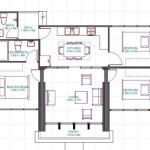Essential Aspects of Electrical Wiring Plan For House
An electrical wiring plan is a detailed diagram that outlines the layout of electrical circuits, outlets, switches, and other electrical components within a building. It serves as a blueprint for electricians to ensure that the electrical system is safe, efficient, and meets building codes and standards.
Creating an electrical wiring plan requires careful planning and consideration of various factors. Here are some essential aspects to consider when developing an electrical wiring plan for a house:
1. Load Calculation
Before designing the wiring plan, it is crucial to determine the electrical load requirements of the house. This involves calculating the total wattage of all electrical appliances, lighting fixtures, and other devices that will be used in the house. Accurate load calculation is essential to ensure that the electrical system can handle the maximum demand without overloading.
2. Circuit Design
The electrical wiring plan should divide the electrical system into multiple circuits. Each circuit is designed to handle a specific load and is protected by a circuit breaker or fuse. Circuits should be grouped logically based on the location and function of the electrical devices they serve. Proper circuit design helps distribute electrical load evenly and prevents overheating.
3. Outlet and Switch Placement
The placement of electrical outlets and switches is critical for convenience and safety. Outlets should be strategically located to provide easy access to appliances and devices. Switches should be placed in convenient locations for controlling lighting and other electrical functions. The number and spacing of outlets and switches should comply with electrical codes.
4. Grounding and Bonding
Grounding and bonding are essential safety measures that protect against electrical shock and ensure the proper functioning of electrical equipment. The electrical wiring plan should include provisions for grounding all electrical components and bonding metal enclosures and frames to the grounding system.
5. Lighting Design
The electrical wiring plan should consider the lighting requirements of the house. This involves determining the type of lighting fixtures, their placement, and the control systems used. Adequate and well-distributed lighting ensures safety, comfort, and aesthetic appeal.
6. Wire Sizing and Protection
The electrical wiring plan should specify the size and type of electrical wires used for each circuit. Wire size is determined based on the load it will carry and the voltage drop considerations. Proper wire selection ensures that the wires can safely handle the electrical current without overheating or creating voltage drop issues.
7. Code Compliance
The electrical wiring plan must adhere to the latest electrical codes and standards. These codes ensure the safety and reliability of the electrical system. Compliance with electrical codes is crucial for obtaining permits, passing inspections, and ensuring insurance coverage.
8. Future Expansion
Consider future expansion when developing the electrical wiring plan. Additional circuits and outlets may be required in the future as the house undergoes renovations or expands. Incorporating provisions for future expansion will save time and effort in the long run.
9. Documentation and Labeling
The electrical wiring plan should be well-documented and labeled for easy reference and maintenance. It should include a detailed legend explaining the symbols and notations used. Proper labeling of circuits, outlets, and switches will simplify troubleshooting and future modifications.
10. Professional Installation
It is highly recommended to hire a qualified licensed electrician for the installation and maintenance of the electrical wiring system. DIY electrical work can be dangerous and may not meet electrical codes. A professional electrician will ensure the safety and reliability of the electrical system.
An electrical wiring plan is a vital component of any house. By considering the essential aspects outlined above, homeowners can ensure that their electrical system is safe, efficient, and meets their specific needs. Proper planning, adherence to codes, and professional installation will result in a reliable electrical system that will serve the house well for many years to come.

Free House Wiring Diagram Edrawmax

House Wiring Diagram Everything You Need To Know Edrawmax
Create An Electrical Plan Roomsketcher Help Center

Residential Wiring Diagrams And Layouts House Home Electrical

House Wiring Diagram Everything You Need To Know Edrawmax

Creating Electrical Plans 1st Construction

Electrical House Plan Details Engineering Discoveries Wiring Diagram Home

House Electrical Wiring Layout Complete Beginners Guide

How To Create A House Wiring Diagram Complete Guide Edrawmax

Diy Home Wiring Diagram Simulation Kris Bunda Design








